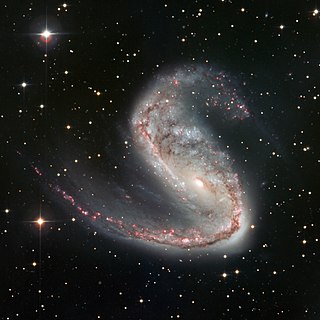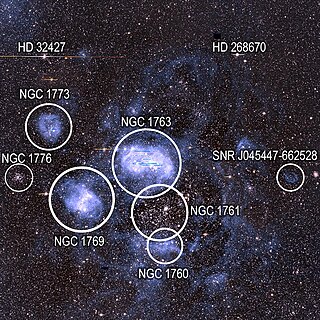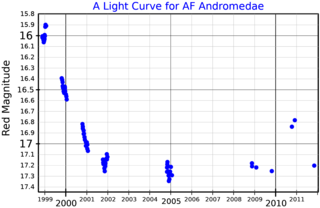
The Pinwheel Galaxy is a face-on spiral galaxy 21 million light-years away from Earth in the constellation Ursa Major. It was discovered by Pierre Méchain in 1781 and was communicated that year to Charles Messier, who verified its position for inclusion in the Messier Catalogue as one of its final entries.

The cosmic distance ladder is the succession of methods by which astronomers determine the distances to celestial objects. A direct distance measurement of an astronomical object is possible only for those objects that are "close enough" to Earth. The techniques for determining distances to more distant objects are all based on various measured correlations between methods that work at close distances and methods that work at larger distances. Several methods rely on a standard candle, which is an astronomical object that has a known luminosity.

Centaurus A is a galaxy in the constellation of Centaurus. It was discovered in 1826 by Scottish astronomer James Dunlop from his home in Parramatta, in New South Wales, Australia. There is considerable debate in the literature regarding the galaxy's fundamental properties such as its Hubble type and distance. NGC 5128 is one of the closest radio galaxies to Earth, so its active galactic nucleus has been extensively studied by professional astronomers. The galaxy is also the fifth-brightest in the sky, making it an ideal amateur astronomy target. It is only visible from the southern hemisphere and low northern latitudes.

The Whirlpool Galaxy, also known as Messier 51a (M51a) or NGC 5194, is an interacting grand-design spiral galaxy with a Seyfert 2 active galactic nucleus. It lies in the constellation Canes Venatici, and was the first galaxy to be classified as a spiral galaxy. It is 32 million light-years away and 109,000 ly (33,280 pc) in diameter.

Messier 81 (also known as NGC 3031 or Bode's Galaxy) is a grand design spiral galaxy about 12 million light-years away in the constellation Ursa Major. It has a D25 isophotal diameter of 29.44 kiloparsecs (96,000 light-years). Because of its relative proximity to the Milky Way galaxy, large size, and active galactic nucleus (which harbors a 70 million M☉ supermassive black hole), Messier 81 has been studied extensively by professional astronomers. The galaxy's large size and relatively high brightness also makes it a popular target for amateur astronomers. In late February 2022, astronomers reported that M81 may be the source of FRB 20200120E, a repeating fast radio burst.

NGC 281, IC 11 or Sh2-184 is a bright emission nebula and part of an H II region in the northern constellation of Cassiopeia and is part of the Milky Way's Perseus Spiral Arm. This 20×30 arcmin sized nebulosity is also associated with open cluster IC 1590, several Bok globules and the multiple star, B 1. It collectively forms Sh2-184, spanning over a larger area of 40 arcmin. A recent distance from radio parallaxes of water masers at 22 GHz made during 2014 is estimated it lies 2.82±0.20 kpc. from us. Colloquially, NGC 281 is also known as the Pacman Nebula for its resemblance to the video game character.

NGC 2403 is an intermediate spiral galaxy in the constellation Camelopardalis. It is an outlying member of the M81 Group, and is approximately 8 million light-years distant. It bears a similarity to M33, being about 50,000 light years in diameter and containing numerous star-forming H II regions. The northern spiral arm connects it to the star forming region NGC 2404. NGC 2403 can be observed using 10×50 binoculars. NGC 2404 is 940 light-years in diameter, making it one of the largest known H II regions. This H II region represents striking similarity with NGC 604 in M33, both in size and location in galaxy.

NGC 3982, also known as UGC 6918, is an intermediate spiral galaxy approximately 68 million light-years away in the constellation Ursa Major. It was discovered by William Herschel on April 14, 1789, and misclassified as a planetary nebula. NGC 3982 is a part of the M109 Group.

NGC 3184, the Little Pinwheel Galaxy, is a spiral galaxy approximately 40 million light-years away in the constellation Ursa Major. Its name comes from its resemblance to the Pinwheel Galaxy. It has two HII regions named NGC 3180 and NGC 3181.

Luminous blue variables (LBVs) are massive evolved stars that show unpredictable and sometimes dramatic variations in their spectra and brightness. They are also known as S Doradus variables after S Doradus, one of the brightest stars of the Large Magellanic Cloud. They are considered to be rare.

NGC 4414 is an unbarred spiral galaxy about 62 million light-years away in the constellation Coma Berenices. It is a flocculent spiral galaxy, with short segments of spiral structure but without the dramatic well-defined spiral arms of a grand design spiral. Four supernovae have been observed in this galaxy: SN 1974G, SN 2013df, SN 2021J, and SN 2023hlf.

NGC 2442 and NGC 2443 are two parts of a single intermediate spiral galaxy, commonly known as the Meathook Galaxy or the Cobra and Mouse. It is about 50 million light-years away in the constellation Volans. It was discovered by Sir John Herschel on December 23, 1834 during his survey of southern skies with a 18.25 inch diameter reflecting telescope from an observatory he set up in Cape Town, South Africa. Associated with this galaxy is HIPASS J0731-69, a cloud of gas devoid of any stars. It is likely that the cloud was torn loose from NGC 2442 by a companion.

NGC 2366 is a Magellanic barred irregular dwarf galaxy located in the constellation Camelopardalis.

NGC 7252 is a peculiar galaxy resulting from an interaction between two galaxies that started a billion years ago. It is located 220 million light years away in the constellation Aquarius. It is also called Atoms for Peace Galaxy, a nickname which comes from its loop-like structure, made of stars, that resembles a diagram of an electron orbiting an atomic nucleus.

NGC 2363-V1 is a luminous blue variable star in the star-forming region NGC 2363, at the far southwestern part of the irregular galaxy NGC 2366 in the constellation Camelopardalis, near the north celestial pole nearly 11 million light years away from our galaxy. It was discovered in 1996 by Laurent Drissen, Jean-René Roy, and Carmelle Robert while examining images taken by the Hubble Space Telescope Wide Field Planetary Camera 2.

N11 is the brightest emission nebula in the north-west part of the Large Magellanic Cloud in the Dorado constellation. The N11 complex is the second largest H II region of that galaxy, the largest being the Tarantula Nebula. It covers an area approximately 6 arc minutes across. It has an elliptical shape and consists of a large bubble, generally clear interstellar area, surrounded by nine large nebulae. It was named by Karl Henize in 1956.

NGC 6621 is an interacting spiral galaxy in the constellation Draco. It lies at a distance of circa 260 million light-years. NGC 6621 interacts with NGC 6622, with their closest approach having taken place about 100 million years before the moment seen now. The pair was discovered by Edward D. Swift and Lewis A. Swift on June 2, 1885. Originally NGC 6621 was assigned to the southeast galaxy, but now it refers to the northern one. NGC 6621 and NGC 6622 are included in the Atlas of Peculiar Galaxies as Arp 81 in the category "spiral galaxies with large high surface brightness companions".
Carmelle Robert is a Quebec astrophysicist, starburst researcher and professor at the Department of Physics, Physical Engineering and Optics at Université Laval, in Quebec City, Quebec.

AF Andromedae is a luminous blue variable (LBV), a type of variable star. The star is one of the most luminous variables in M31, the Andromeda Galaxy.


















